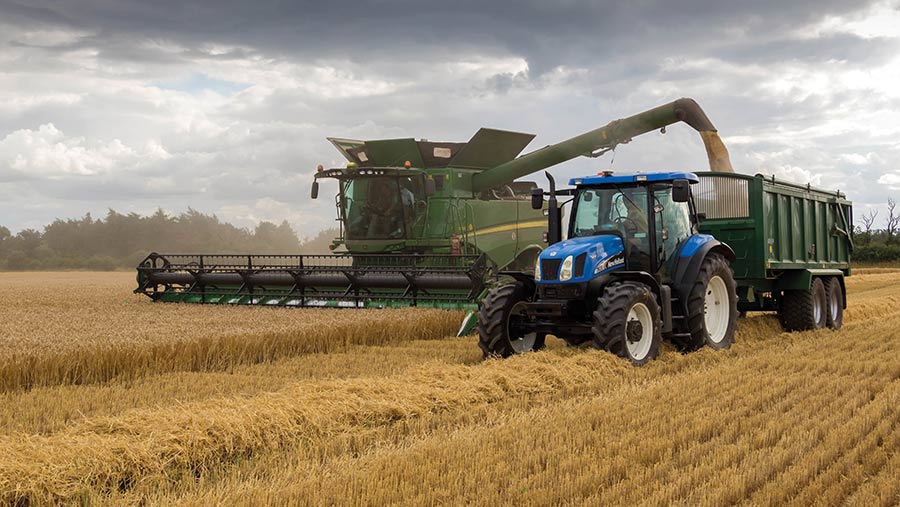How to grow a better spring malting barley crop
 © Tim Scrivener
© Tim Scrivener Spring malting barley is sometimes thought of as one of the most straightforward crops to manage, but there are practices which can greatly improve the chances of producing a good malting crop.
Weather too, can have a significant effect. Rain during flowering can result in fusarium in the ear and rejection of the crop. Rain in the run-up to harvest can cause increased skinning, potentially leading to grain being rejected.
Delays at harvest can cause issues with germination, again leading to rejection. And a wet run-in can also increase the threat from the dreaded ramularia.
Andrew Gilchrist, managing director and an agronomist at the advisory group Scottish Agronomy takes us through some of the best practices when growing the crop.
See also: How to grow a 10t/ha-plus malting spring barley crop
Good malting crop
First, choose the right variety. The Scottish market is predominantly for malt distilling; the English market is mainly for brewing. For malt distilling there are only three approved varieties – Laureate, Diablo and Sassy.
For brewing there are also three varieties approved – Planet, Laureate and Diablo. Not a big choice. All are high-yielding and high-quality. First box ticked.
Seed rates will potentially differ throughout the UK. We are experienced with Scottish conditions, so I can say that aiming to sow at somewhere between 350 and 450 seeds/sq m will put you in the right place in Scotland.
The wiggle room is to accommodate early sowing/late sowing/cracking seed-beds/poor seed-beds. Just a bit of common sense is required.
Scottish timing
Optimum drilling timing in Scotland is somewhere between early March and mid-April, depending on geographical location. Easter Ross, the Angus coast, East Fife and East Lothian tend to be more forgiving of early sowings.
Seed-bed preparation for the majority of Scottish barley crops is some form of inversion tillage. Minimum-tillage or direct drilling can work, but you are more reliant on the weather gods being kind in the post-establishment period. Spring barley roots will not tolerate sitting in wet soils for any length of time.
Nitrogen fertiliser has to be applied early – no later than the three-leaf stage for malt distilling, ideally earlier. If all is applied on the seed-bed there is a greater risk of leaching. If it all goes on late, the chances of hitting the required grain specification diminishes.
A good compromise is 70% applied before crop emergence and then 30% applied at early crop emergence. The amount of nitrogen fertiliser needed to achieve malt distilling specification (below 1.65% grain nitrogen) is normally in the range of 110-130kg/ha.
The modern varieties tend to handle more nitrogen fertiliser, as they yield more and this has the effect of diluting grain nitrogen.
Weed control
After that, it’s easy. Weed control is usually mainly keeping on top of meadowgrass and broad-leaved weeds – not blackgrass. The majority of the main hit on weeds happens at pre-emergence to early post-emergence, with a top-up, if required, at the T1 stage.
Further sprays at T1 would be a cheap fungicide (although we have now lost the cheapest option, chlorothalonil) and probably some manganese treatment (Scottish soils are prone to this deficiency).
Some plant growth regulator treatment may also be appropriate in a fertile scenario. The biggest challenge in terms of disease control comes later.
Ramularia has become a bigger issue since the banning of chlorothalonil, which was a very effective barrier to the disease when applied at awn emergence. There is nothing as effective, although the new azole from BASF, mefentrifluconazole (Revysol), has useful activity.
This azole is available mixed with the SDHI fungicide fluxapyroxad as Revystar.
Unfortunately, this has significantly increased the fungicide spend, and there is no sign of genetic resistance anytime soon. Beyond awn emergence it’s a case of sitting back and waiting for harvest – although glyphosate is commonly used as a harvest aid.
Malting premiums will wax and wane, but at least Laureate and Diablo have taken yields to a different level, almost challenging those of winter barley.

